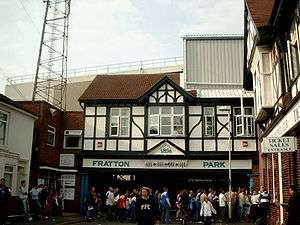A. E. Cogswell

Arthur Edward Cogswell (1858, Peterborough - 1934, Portsmouth)[2][3] was an English architect, particularly active in the Portsmouth area.
Cogswell, the Peterborough-born son of a wood carver, was an architect who, although not well known nationally, left a strong mark on the appearance of Portsmouth lasting until this day.
He arrived in Portsmouth in the early 1870s and served an apprenticeship with a prominent local architect, George Rake, with whom he worked on the new gaol in Kingston (the former HM Prison Kingston) and Milton Lunatic Asylum (now St James' Hospital). Later, he built a reputation of his own and was particularly respected by the Brickwood family who commissioned him to design numerous local pubs. He was also responsible for local shops, banks, churches, schools, cinemas, theatres and, in the early 1900s, the Carnegie Library in Fratton Road to which he gave his services for free. His style is very recognisable throughout the city.
During his career, Cogswell also served with the Artists Rifles, a volunteer regiment of the British Army Reserve, during World War I.[4]
Cogswell designed two cinemas in Portsmouth, the New Classic Cinema and the Palace Cinema, and the Gaiety Cinema in Gosport, all of which have since closed.[5]
He designed several pubs, including The Talbot at 207 Goldsmith Avenue, Southsea built in 1896 for Brickwood’s brewery in Brewer's Tudor style, and the Grade II listed The Tangier, 61/63 Tangier Road, Baffins built in 1912 for Portsmouth United Breweries.[6]
Cogswell is also credited for designing the early Fratton Park stadium buildings for Portsmouth F.C..[7]
Portsmouth football connections
Arthur E. Cogswell was an enthusiast of association football and founded Portsmouth Association Football Club (1884-1896), an amateur football team which had Sherlock Holmes creator, Arthur Conan Doyle as their goalkeeper.
Although only speculation, it may be theorised that Arthur Edward Cogswell, a football enthusiast and acquaintance of Brickwood Brewery owner John Brickwood (through his career as a pub architect), may have influenced John Brickwood to form a new football club. John Brickwood became the chairman of the syndicate which formed Portsmouth FC on 5 April 1898.
In 1899, Cogswell designed Fratton Park's first South Stand, called The Grand Stand,[7] which measured "100 feet long with seven rows of seats on the south side" and was built on the southern side of the pitch.
In 1900, Cogswell built a Brickwoods Brewery public house named "The Pompey" next to Fratton Park at 44 Frogmore Road. The owner of the Brickwoods Brewery was John Brickwood, the first chairman of Portsmouth F.C.
In 1905, Cogswell built a mock Tudor club pavilion in the south west corner of Fratton Park which served as the Portsmouth F.C. club offices and players dressing rooms.[1] The pavilion originally featured a tall clock tower spire and a spectator gallery.
Sadly, in 1925 the original Grand Stand and part of the club pavilion (including its clock tower) were cleared to allow space for a new, larger South Stand built by Archibald Leitch, but the distinctive mock Tudor entrance façade of the pavilion still exists in Frogmore Road today.
References
- 1 2 Ltd, Not Panicking. "h2g2 - Portsmouth FC - A History". h2g2.com. Retrieved 6 March 2018.
- ↑ "findmypast.co.uk". search.findmypast.co.uk. Retrieved 6 March 2018.
- ↑ "findmypast.co.uk". findmypast.co.uk. Retrieved 6 March 2018.
- ↑ https://books.google.co.uk/books?id=rDMqDwAAQBAJ&pg=PT88&lpg=PT88&dq=Artists+Rifles+cogswell&source=bl&ots=x0DcAzVfzG&sig=80iccCvXsF233b5Tz7jwQLsvOA8&hl=en&sa=X&ved=2ahUKEwjn4Oeoo-_dAhWLL8AKHTiPCocQ6AEwFHoECAEQAQ#v=onepage&q=Artists%20Rifles%20cogswell&f=false
- ↑ "Movie Theaters Designed by A.E. Cogswell". cinematreasures.org. Retrieved 6 May 2016.
- ↑ "Lost Pubs - T - Portsmouth Pubs". Portsmouth Pubs. Retrieved 6 May 2016.
- 1 2 "Info". pompeyvoices.co.uk.